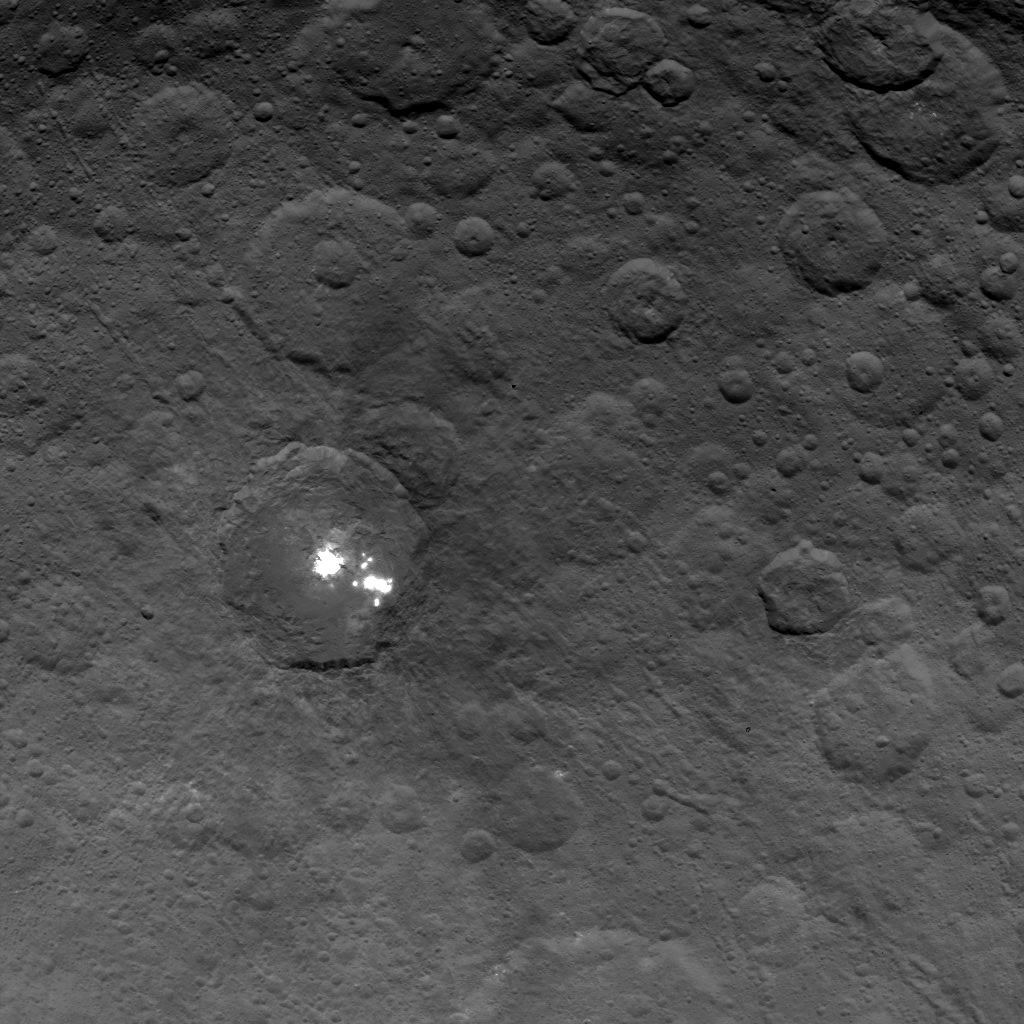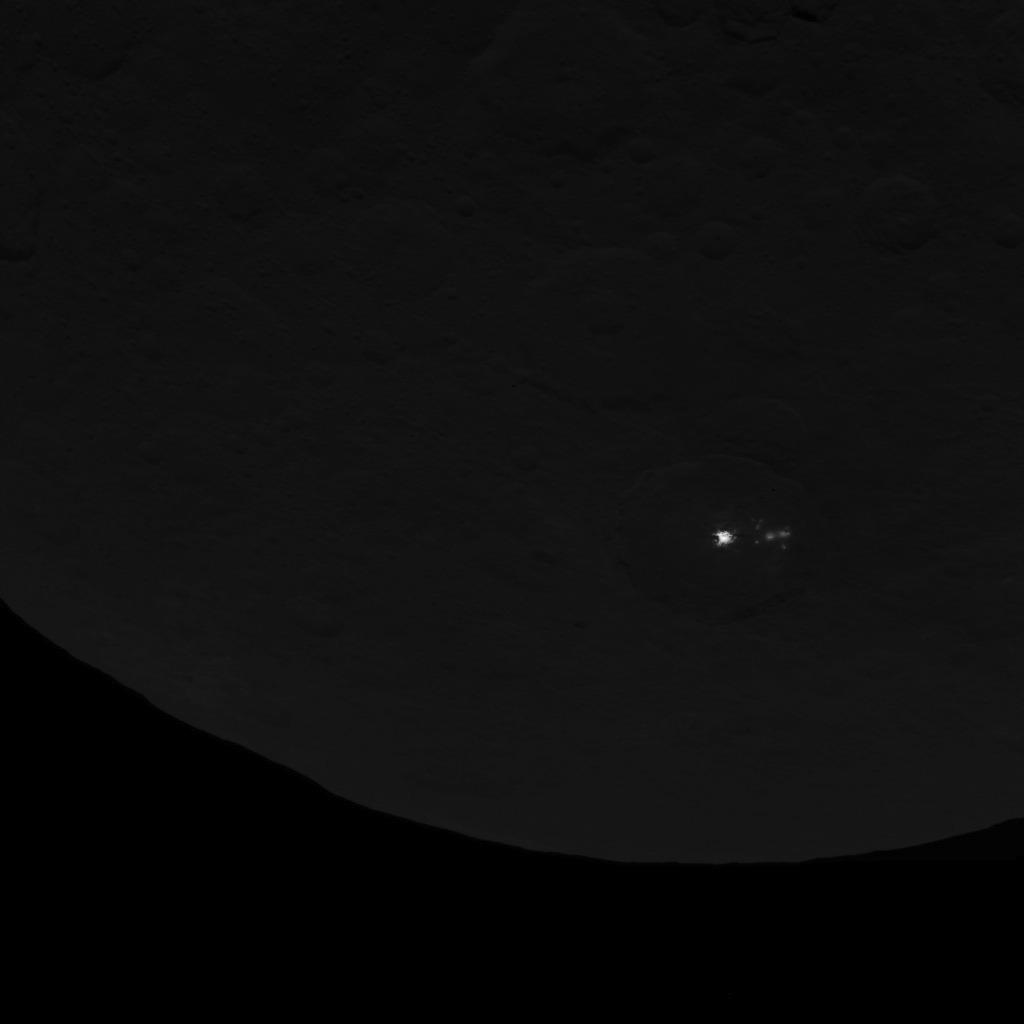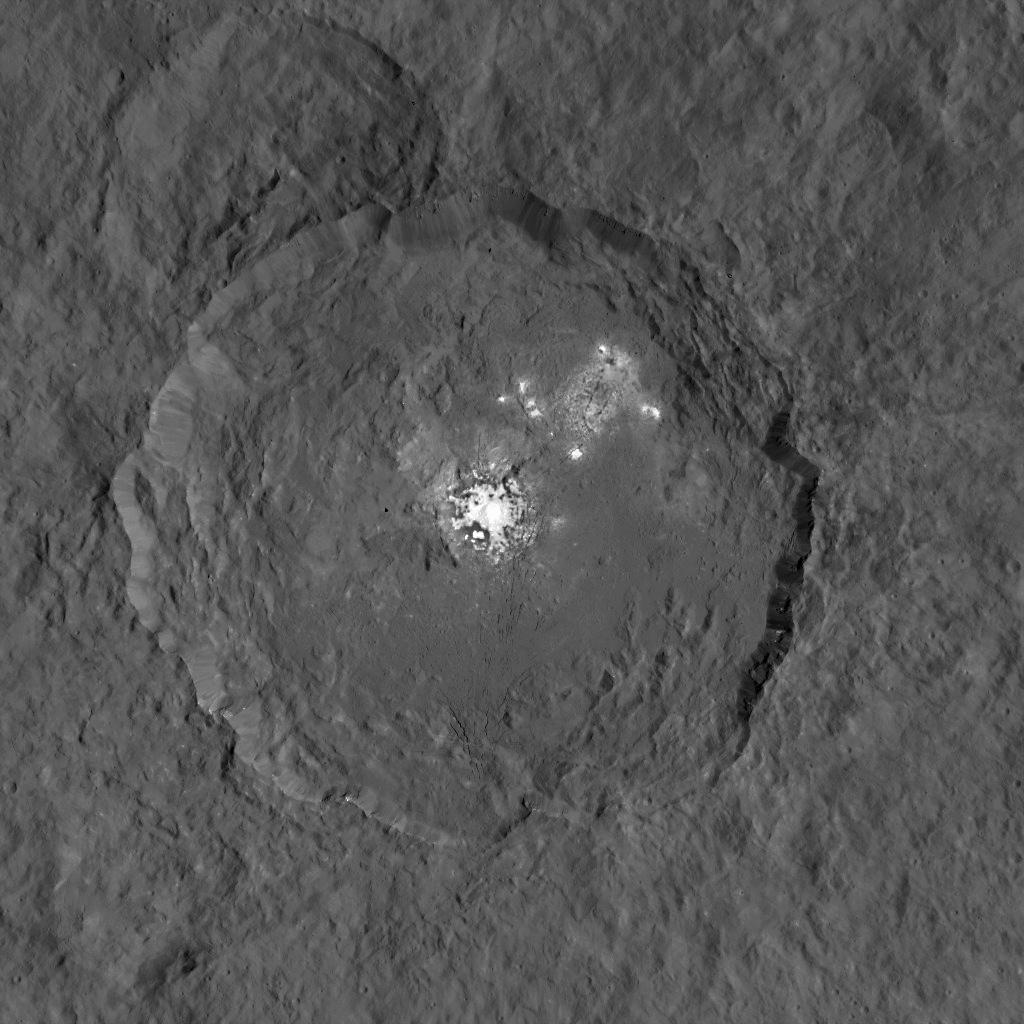|
First Hi-Res Photos of Ceres Are Here!
|
|
| midtskogen | Date: Sunday, 14.06.2015, 18:31 | Message # 31 |
 Star Engineer
Group: Users
 Norway
Norway
Messages: 1674
Status: Offline
| At that resolution they should set the exposure for the bright spots so they don't get overexposed.
NIL DIFFICILE VOLENTI

|
| |
| |
| Destructor1701 | Date: Sunday, 14.06.2015, 23:30 | Message # 32 |
|
Pioneer
Group: Users
 Ireland
Ireland
Messages: 533
Status: Offline
| 
(original uncropped image)

|
| |
| |
| catman007 | Date: Monday, 15.06.2015, 22:15 | Message # 33 |
|
Observer
Group: Newbies
 United States
United States
Messages: 5
Status: Offline
| That uneven bright spot (with all the little ones) on the right...is it curved? It looks to me as if it's crawling up the side of the crater...
Perhaps it's not ice, but some rock/metal similar to obsidian? If it's only in that one crater (or a few of them), then that would mean that the asteroid or whatever hit Ceres had the material in it and the impact caused a sudden creation of a glassy rock.
"Shiny" igneous rocks tend to cool extremely fast, I wonder if that's what's happened here?
|
| |
| |
| Watsisname | Date: Tuesday, 16.06.2015, 05:15 | Message # 34 |
 Galaxy Architect
Group: Global Moderators
 United States
United States
Messages: 2613
Status: Offline
| An intriguing thought. Couple of difficulties though. "Shiny" implies a specular mode of reflectivity, which would appear from orbit as a strong dependence of the spot's brightness on the illumination angle. But we don't really see that here; it looks fairly uniformly bright from any illumination angle. This fits more with what we expect from a high albedo surface, like ice. (The ice may or may not also be "shiny").
The other difficulty is in how the heat would be lost quickly enough. In vacuum, heat can only be lost by thermal radiation, which is fairly slow.

|
| |
| |
| Handbanana | Date: Monday, 29.06.2015, 03:19 | Message # 35 |
 Astronaut
Group: Users
 United States
United States
Messages: 70
Status: Offline
| This is so painful to watch. This guy obviously has zero knowledge about astronomy or space exploration.
Tonight... you.
Edited by Handbanana - Monday, 29.06.2015, 03:20 |
| |
| |
| Watsisname | Date: Monday, 29.06.2015, 05:12 | Message # 36 |
 Galaxy Architect
Group: Global Moderators
 United States
United States
Messages: 2613
Status: Offline
| 99% sure that it's intentionally made to be dumb.

|
| |
| |
| Destructor1701 | Date: Tuesday, 30.06.2015, 19:13 | Message # 37 |
|
Pioneer
Group: Users
 Ireland
Ireland
Messages: 533
Status: Offline
| Quote midtskogen (  ) At that resolution they should set the exposure for the bright spots so they don't get overexposed.


|
| |
| |
| FastFourierTransform | Date: Wednesday, 09.09.2015, 14:51 | Message # 38 |
 Pioneer
Group: Local Moderators
 Spain
Spain
Messages: 542
Status: Offline
| Glorious Occator 

|
| |
| |
| Salvo | Date: Wednesday, 09.09.2015, 17:26 | Message # 39 |
 Star Engineer
Group: Local Moderators
 Italy
Italy
Messages: 1400
Status: Offline
| Ice? Really? Wow 
The universe is not required to be in perfect harmony with human ambition.
CPU: Intel Core i7 4770 GPU: ASUS Radeon R9 270 RAM: 8 GBs
(still don't know why everyone is doing this...)
|
| |
| |
| Watsisname | Date: Wednesday, 09.09.2015, 18:48 | Message # 40 |
 Galaxy Architect
Group: Global Moderators
 United States
United States
Messages: 2613
Status: Offline
| Nice!
Also, don't know if anyone heard about the haze over the bright spots? Suggests that this is indeed ice which sometimes sublimates in the sun, producing a thin localized atmosphere. How cool is that? 

|
| |
| |
| Bells_Theorem | Date: Thursday, 10.09.2015, 21:22 | Message # 41 |
 Explorer
Group: Users
 United States
United States
Messages: 188
Status: Offline
| Quote Salvo (  ) Ice? Really? Wow
More likely salts, not ice according to NASA.
Quote In examining the way Occator's bright spots reflect light at different wavelengths, the Dawn science team has not found evidence that is consistent with ice. The spots' albedo - a measure of the amount of light reflected - is also lower than predictions for concentrations of ice at the surface.
https://www.nasa.gov/jpl/dawn-sends-sharper-scenes-from-ceres
|
| |
| |
| Watsisname | Date: Thursday, 10.09.2015, 22:54 | Message # 42 |
 Galaxy Architect
Group: Global Moderators
 United States
United States
Messages: 2613
Status: Offline
| It's ice, it's salt, it's salty ice?
Interesting that the albedo is lower than expected of ice, but Ceres has a pretty dark surface. Easy overexposure even if it's not nearly white.

|
| |
| |
| Watsisname | Date: Sunday, 13.12.2015, 08:34 | Message # 43 |
 Galaxy Architect
Group: Global Moderators
 United States
United States
Messages: 2613
Status: Offline
| It's salty ice! (More work still to be done, for sure, but it looks like they're getting a pretty strong working hypothesis together).
http://www.jpl.nasa.gov/news/news.php?feature=4785
http://www.nature.com/nature/journal/v528/n7581/full/nature15754.html

|
| |
| |
| steeljaw354 | Date: Tuesday, 22.12.2015, 22:24 | Message # 44 |
 World Builder
Group: Users
 Pirate
Pirate
Messages: 862
Status: Offline
| One of my favorite planets.
|
| |
| |
| Breno | Date: Friday, 25.03.2016, 00:43 | Message # 45 |
|
Observer
Group: Users
 Brazil
Brazil
Messages: 13
Status: Offline
| I know the topic is kinda dead, but 2 days ago NASA released new images from Ceres and information its about chemical composition.

Bright Spots and Color Differences Revealed on Ceres
|
| |
| |